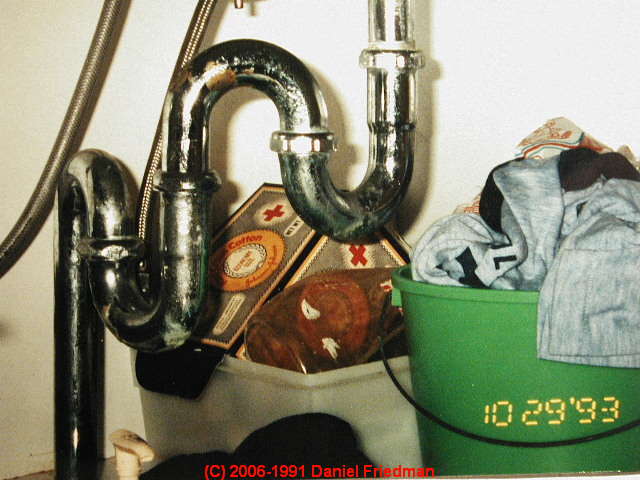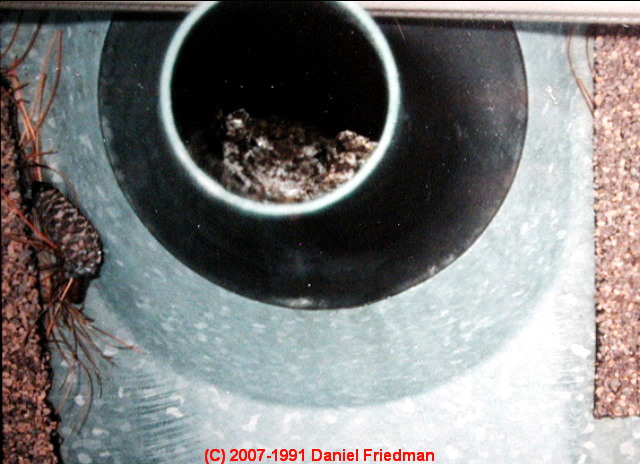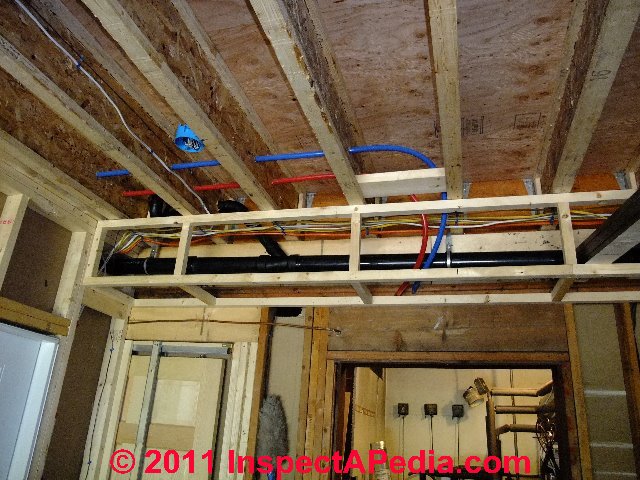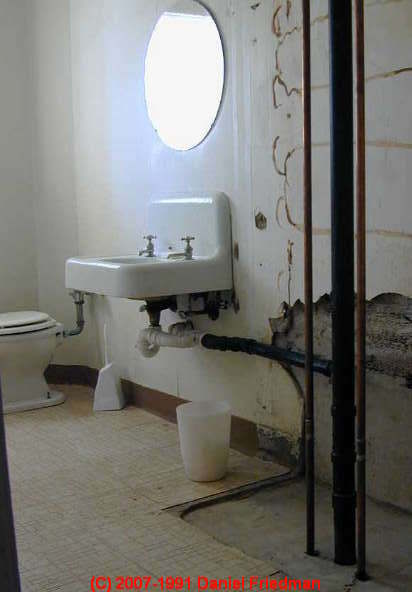 Plumbing Drain Noises
Plumbing Drain Noises
Diagnosis & repair of glub-glub, burbling, and other drain sounds
- POST a QUESTION or COMMENT on Diagnosing the Source of Plumbing Drain Noises and on reducing plumbing drain noise in buildings
Plumbing drain noise diagnosis:
This article discusses how to identify different types of plumbing drain sounds, including the cause, diagnosis, and cure of different sorts of plumbing drain noises - how to find, identify, and diagnose the source of plumbing drain, waste, and vent piping and plumbing fixture sounds.
We discuss how to add sound deadening insulation around new work or into existing plumbing pipe routes in buildings. We also cover: What causes noisy plumbing drains? How to investigate & repair plumbing drain sounds.
Add sound insulation to reduce plumbing drain noise transmission in homes. Drain noise complaints due to a V200 anti-siphon valve.
That "blub blub" or "glug glug" noise you hear from a building drain might mean that there is a problem with the drain system itself, such as a partial drain blockage, a drain venting problem, a drain odor problem, or even a failing septic system.
This article also explains how to determine the causes of plumbing drain noises, and we refer to key companion articles that assist in that diagnosis, and we include plumbing noise cures.
InspectAPedia tolerates no conflicts of interest. We have no relationship with advertisers, products, or services discussed at this website.
- Daniel Friedman, Publisher/Editor/Author - See WHO ARE WE?
How to Diagnose Sounds of Gurgling or Other Noises in a Building Drain Piping System
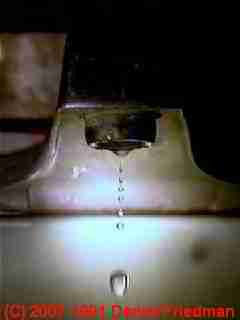 As we explain in more detail at PLUMBING DRAIN NOISE REPAIR, we divide plumbing drain and fixture noises into two groups:
As we explain in more detail at PLUMBING DRAIN NOISE REPAIR, we divide plumbing drain and fixture noises into two groups:
- Plumbing defect noises
associated with plumbing system problems or defects whose identification and diagnosis is discussed here. - Normal (but annoying) plumbing system noises
that will be corrected by noise transmission control or sound insulation are discussed at SOUND CONTROL for PLUMBING
[Click to enlarge any image]
Article Contents
- DRAIN NOISE DUE to INADEQUATE VENTING - causes of noises & slow drain complaints due to insufficien venting
- BLOCKED PLUMBING VENT & GURGLING / SLOW DRAINS - glub glub noises from toilets or other fixtures
- GURGLING DRAINS
- SOUNDS of RUNNING / DRIPPING WATER in DRAINS
- NORMAL PLUMBING SOUNDS
- HOW TO FIND THE SOURCE OF PLUMBING NOISES
- REPAIR PLUMBING SYSTEM NOISES
Inadequate or missing plumbing vents & noisy, gurgling, or slow plumbing drains
If a gurgling sound is heard at a sink or shower drain only when a nearby toilet is flushed, or at a sink or shower when a nearby tub is draining, we'd suspect that the building drain-vent system is inadequate.
This photograph shows a multiple-trap drain on a building sink - forming a double "S-trap"
which lacks venting and also is very prone to clogging.
In addition to watching for
eccentric home-made plumbing traps like this pair that are likely to cause bad
sink, shower, or tub drainage, check for the following:
- Plumbing fixtures installed with no vent connection at all,
such as a bathroom or kitchen sink that use an "S" shaped plumbing trap. - Vacuum breakers at drains:
Plumbing fixtures originally installed with no vent connection to which a (sometimes permitted) local plumbing vent/vacuum breaker (such as a "V-200 plumbing vent) usually installed right under the sink to permit air to enter the plumbing drain line as needed but intended to keep sewer gases from exiting that same drain - a one-way valve.
If the valve is defective or "stuck", inadequate, or improperly installed this problem may occur. - Plumbing fixtures that are installed too distant
(perhaps more than 5') from the vertical plumbing stack vent that is supposed to serve them. - Island sink vents:
special case of this plumbing venting problem can occur at island sinks installed in kitchens. Special drain vent piping details are required to assure that such isolated fixtures will drain properly.
See ISLAND SINK PLUMBING VENTS - Plumbing fixtures whose vent diameter is too small
in the building or above the roof line - resulting in frost clogging in freezing climates - Plumbing fixtures whose vent line in an attic was not extended to outside
the building (lead to indoor odors and potentially dangerous, explosive methane gas accumulation. - Plumbing vents clogged
by insect nests, animals, or vent material deterioration such
as TRANSITE PLUMBING VENTS
Blocked plumbing venting & gurgling or slow plumbing drains
Photo above: a frog resting in the plumbing, seen from the rooftop, explained gurgling slow drains at this building.
A plumbing drain line could itself blocked, as opposed to a blocked or inadequate plumbing vent line. In the case of a partially blocked plumbing drain, case all of the fixtures served by that drain line will always be slow to drain.
When weather and safe access permit going onto a roof (or using the services of a professional for that purpose), check for blocked building plumbing vents such as plumbing vents that may have become blocked by an insect nest, birds nest, or as shown in this photo, a frog.
In freezing climates, check in winter to be sure that the plumbing vents are not being
blocked by frost or by snow-cover.
See COLD WEATHER SEPTIC / SEWAGE ODOR DIAGNOSIS
Gurgling drains may indicate a partially blocked or sluggish sewer piping or or blockages in the private septic system
If the outside sewer line is partially blocked, or if waste piping to a septic tank or from a septic tank to a drainfield is partially blocked, the building drains may appear to work normally until there is a surge of usage such as an increase in occupants or when using a washing machine.
In lighter usage the waste and wastewater flow down into the main drain line or sewer line where they are in effect, "stored" while the waste slowly seeps past the partial blockage. As wastewater seeps past the partial main drain blockage a gurgling sound may be produced at fixtures in the building as air is drawn intermittently into the drains - an effect more pronounced if the building drain vent system is inadequate.
In heavier usage of building fixtures, such as when there are many occupants or when doing laundry, the additional volume of water may first cause this "gurgling drain" symptom to be more pronounced, and as the blockage worsens, the building drains may actually back up during heavy use. This condition can also produce sewage smells or sewer gas backups into a building.
Gurgling drains heard indoors may also be caused by a clogged septic filter, as reader Will pointed out
(at SEPTIC FILTER CLOGGING SIGNS 2017/01/14), or by clogging anywhere that blocks sewage into or out of a septic tank.
At the end of this article we list further diagnostic advice for plumbing noise diagnosis & repair, curing blocked drains, diagnosing blocked septic systems, or detecting inadequate plumbing vent systems.
Also see SEPTIC BACKUP PREVENTION (private septic systems)
SEWER BACKUP PREVENTION (buildings connected to municipal sewers)
and also see the health and safety concerns discussed
at SEWER GAS ODORS.
Sounds of running or dripping water in a building drain
Continuous Plumbing Drain Sounds like Trickling Water or Water Dripping Noises
Trickling water sounds coming from a building drain or fixture might indicate a fixture leak problem.
A sound of dripping heard inside a drain line, or the sound of continuous running water may be heard.
Both of these can indicate that a plumbing fixture in the building has a water supply leak which is leaking into the fixture.
If the drip and sound are occurring outside of the fixture or its drain, such leaks are usually discovered pretty quickly when water or leak stains appear in the building.
But a plumbing leak that causes a toilet to run, the only clues might be noticing that the toilet fill valve is sometimes re-filling the tank even though no one has used the toilet, or one might hear water running in the building drains, or if the property is served by a private septic system, the system may experience flooding and backups.
Also see SINK LEAK DIAGNOSIS & REPAIR where we discuss repairing a leaky (and dripping) sink drain basket / strainer assembly.
Normal plumbing drain sounds
Hearing the sound of running water in a building drain is not likely to indicate a problem with the drain system itself. In older buildings where cast iron and steel drain pipes were used, not much sound normally is heard: even the sound of running water, say when a shower is running or when a toilet was flushed.
But in a more modern structure that uses plastic or copper drain piping these materials can transmit the sound of running water to the building interior. Builders can reduce sound transmission from plumbing lines by enclosing them in insulated chaseways.
We have also found cases in pipes in a building transmit sounds from one area of the building to another. We've also found that electromagnetic fields generated in a building, say by a bank of electric meters located in one area, can be transmitted to other building areas through metal piping.
Normal (but annoying) plumbing system noises that will be corrected by noise transmission control or sound insulation are discussed
at SOUND CONTROL for PLUMBING,
a section of SOUND CONTROL in buildings where we describe controlling the transmission of plumbing noises in buildings.
How to find the source of plumbing drain sounds
An experienced plumber can often diagnose these problems quite quickly since s/he is more familiar with plumbing problems than most homeowners. But if you want to do some drain sound detective work yourself here are some steps that might help.
- Identify the fixture:
Identify which fixtures are producing the sound: is it all fixtures in the building?
If so we suspect a system drain problem or that the building has only a single inadequate vent system or no venting at all. If the sound occurs only at a specific fixture, we suspect a blockage or vent problem local to that bath, kitchen, or laundry area and its vent or drain piping. - Flush the toilets:
Blocked or inadequate vents can produce slow drains as well as noise. But if none of the drains are slow, but you hear gurgling at a nearby sink when the toilet is flushed, take a look underneath the sink.
If the trap is shaped like an "S" over on its side, the sink is probably not vented and the flushing toilet is trying to draw air into the drain line from the nearby sink when the toilet is flushed.
If the trap is shaped like a "P" over on its side, with its horizontal outlet running into the wall, we can't see if the sink is really vented or not, but the style of plumbing is more modern and it might be vented.
If the trap is some crazy combination of multiple bends and parts, call a professional plumber to unsnarl the installation since such jury-rigged plumbing traps are likely to be problematic. - Look for other appliances or systems that are sending water or waste into the building drains:
dishwasher or clothes washer cycling, even a heat pump or air conditioner condensate pump cycling to send water into the drain system may make periodic drain noises. - Look in the attic
for a plumbing drain line that passes vertically up from the floors below and out through the roof. If you can't find one, the building may not have proper plumbing vents. - Look outside
for plumbing vent pipes poking up through the roof in one or more areas. If you see a plumbing vent at one far end of the building where baths are located, but no plumbing vent stack pipe over the end of the building where a kitchen or laundry are located, those rooms may have been built without proper plumbing venting. - Check the plumbing venting system -
A blocked plumbing vent can cause poor drainage and gurgling sounds at drains;
See PLUMBING VENT NOISE - Check for slow or blocked drains
See CLOGGED DRAIN DIAGNOSIS & REPAIR - Check for poor sound isolation or sound insulation around plumbing drains
See SOUND CONTROL for PLUMBING - Check out the septic system (or main sewer line connection):
for signs of backup, blockage, or odors outside.
Effluent breaking out to the surface, muddy or soggy areas, smelly areas, may indicate that the septic system, or part of it, are failing and are periodically not accepting waste.
Check the private septic system (if your building uses one) - for blockages in the line from building to septic tank, for solids blocking the septic tank inlet or outlet, or for a clogged septic tank filter
(SEPTIC FILTER CLOGGING SIGNS) or for a clogged or blocked drainfield piping. - Call a plumber
to investigate further by visual inspection, drain pressure tests, or using a drain camera or scope - Try our plumbing noise diagnostic checklist
found at PLUMBING NOISE CHECKLIST
How to repair problems causing plumbing drain sounds
Suggestions for repairing or reducing plumbing drain noises and sounds are at
PLUMBING DRAIN NOISE REPAIR.
Excerpts are below.
What can we do about the loud noises coming from the plumbing drains in our home?
An InspectAPedia reader asked:
We moved into our home 6 years ago and whenever the ensuite toilet is flushed we can hear the water very loudly go down through the pipes. Recently, whenever ANY toilet is flushed or a sink drained on the 2nd floor we can hear the water travel down the pipes.
What is the cause and how can we fix it? Thank you. Kathy in Calgary
[Our photo above shows ABS drain/waste/vent piping (DWV Piping) in a ceiling pipe chase in a New York home during a recent building addition project, courtesy of Galow Homes.
The sound insulation steps for this plumbing drain and pipe chase are illustrated in detail
Reply: explanation of plumbing drain noise transmission and suggestions for adding sound insulation
Kathy, I am guessing that your home is fairly new and that the drain piping is ABS plastic (or PVC plastic) run in walls or pipe chases that at least in part pass through building interior walls or ceilings.
Those pipes are indeed noisy and the noise is easily transmitted to the room interiors. By contrast, older buildings that used cast iron drain piping find there is less noise transmitted by wastewater running through the drains.
The level of noise transmitted is a combination of the acoustic transmission properties of the thinner walled plastic piping, the proximity of the piping to occupied space, the absence of noise insulation around the pipes, and details of exactly how the pipe was routed and supported.
Specifically, pipes that are in solid contact with building framing or drywall transmit more noise. Pipes that were suspended using acoustic-isolating hangers transmit less noise to the building interior.
As we cite
According to the Canadian CNRC, "Noise reductions up to about 15 dBA can be obtained relative to systems where no resilient mounts are used for pipes."
What to do now to reduce drain pipe noise?
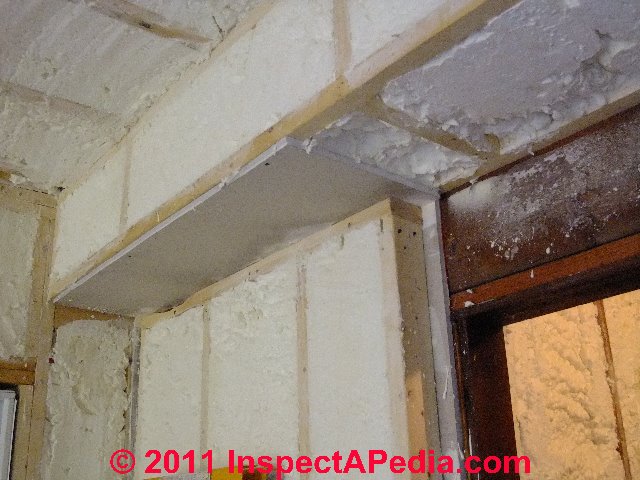 Because it would be costly to tear out ceilings and walls to mess with pipe supports and routing, I'd seriously consider blown-in insulation into the areas where these pipes are routed.
Because it would be costly to tear out ceilings and walls to mess with pipe supports and routing, I'd seriously consider blown-in insulation into the areas where these pipes are routed.
Typically you'd fill the ceiling joist or wall stud bay where the pipe is contained - fill it completely, a step that significantly reduces noise transmission.
Our photo (left) shows what the ceiling pipe chase (and surrounding areas) looked like after a professional blown-in foam insulation job in the same New York home.
Subsequently of course drywall was installed over these surfaces (we do not leave foam insulation exposed because of fire hazards).
After this foam was installed there was no plumbing noise detected in this area when the toilet was flushed in the floor above.
Use foam insulation because it will flow around the piping into odd-shaped spaces and will fill the pipe space completely.
Don't worry, your foam won't have to fill an entire wall or ceiling space, just the space where the pipes actually run, typically 16" or 24" wide by the length of ceiling section or height of wall section by the typical joist or stud width, say 10" or less for 2x10 ceiling joists, and 5 1/2" for 2x6 wall studs or 3.5" for 2x4 wall studs.
Nevertheless the volume of these spaces is more than you can fill consistently, adequately, and economically in a do-it-yourself project using little spray cans of foam purchased at a building supplier. So I recommend hiring a foam insulation installer.
Of course your foam installer should not have to tear off drywall nor foam as extensively as I show in our plumbing chase foam insulation photos above.
Rather it will probably be quite possible to fill the appropriate pipe routing cavities with foam by injecting foam through very small openings spaced along the route of the piping. The result will be no more than occasional 1/2" diameter or less holes to patch and paint along the pipe route.
Install Missing plumbing vents to eliminate odors, sewer gas explosion risks & unsanitary conditions
- Adding missing plumbing vents:
The photo shows a large house with only one plumbing vent visible (click the image for a larger view).
We didn't see vents over or anywhere near the portion of the home which houses a kitchen and bath. While it might be possible for the building to have a working vent system, the combination of its age and other details raised a question worth investigating further.
If we find that there are other "short" plumbing vents which were covered by the deep snow in this photo, they need to be extended.When plumbing vents are simply not provided, the proper repair is to install missing vent piping, up through the building and through its roof.
In old buildings you may see vertical plumbing lines that were added, in plain view, inside the living space.
But modern construction "hides" these pipes in the building walls. If you want to install modern, hidden plumbing vents, and providing your plumber has shown you that in fact they're missing, you may want to wait until other more extensive interior remodeling are in the works. - Vacuum breaker plumbing vents - V-200™:
Meanwhile the plumber may install an illegal vacuum breaker to improve drainage - these products can be added wherever a drain is having trouble getting enough air to flow properly, but in most jurisdictions their use is subject to approval by the local plumbing inspector.
Repair frost-blocked plumbing vents
- Fixing a freezing plumbing vent line:
in which the plumbing vent becomes partially or fully blocked by frost or ice where it extends above the roof in a freezing climate, probably requires the installation of a larger diameter vent from the attic out through the roof. - First check for leaks:
before installing a larger diameter plumbing vent line, make sure that there is not a hot water leak into the plumbing drains or continuous shower use. A water leak into the drain system can result in continuous movement of water vapor or "steam" upwards in the vent system too.
In freezing weather that water vapor may condense and then freeze in the outdoor portion of the plumbing vent system simply because it's passing that way continuously. - Too-short plumbing vent stacks:
A plumbing vent stack which is too short above the building roof can be blocked by snow and then stop venting. But that does not mean that we should be installing very tall (3' to 6') plumbing vents. Except in areas of unusual snow depth such heights are probably much higher than needed.
The plumbing vent stack above a roof needs to be high enough to never be covered by snow, not more.
I speculate (really am guessing) that perhaps if a vent is TOO tall in a cold climate, moist air never will escape at its top because the added cold length of pipe actually encourages freezing.
Other Plumbing System Noises
Noisy water heaters are discussed
at WATER HEATER NOISE DIAGNOSIS, CURE
Stop Sewer Gas or "Sulphur Smell" Odors Caused by clogged plumbing vents, drains, or septic systems
Clogged, partly clogged, slow drains or a partly-blocked, failing drainfield can also cause odors when the surge of water from the washer causes a gas backup in the system: s
ee DIAGNOSE CLOGGED DRAINS for more detailed advice along that problem path.
Watch out: sewer gases contain methane and can cause destructive, even fatal explosions in buildings.
Septic additives like Rid-x won't fix a problem with building vents nor sewer odors, and are generally not recommended anyway - see Additives & Chemicals for septic system maintenance. Are septic products needed? Are septic treatments legal?
...
...
Continue reading at PLUMBING DRAIN NOISE REPAIR - how to fix drain noises, or select a topic from the closely-related articles below, or see the complete ARTICLE INDEX.
Or see PLUMBING DRAIN NOISE DIAGNOSTIC FAQs - questions & answers posted originally on this page.
Or see these
Recommended Articles
- AIR ADMITTANCE VALVE AAV NOISE DIAGNOSIS
- CLOGGED DRAIN DIAGNOSIS & REPAIR - clogged drains may gurgle or burp
- PLUMBING DRAIN NOISE DIAGNOSIS - home
- DRAIN NOISE & slow drain complaints due to plumbing vent problems: causes
- BLOCKED PLUMBING VENT & GURGLING / SLOW DRAINS - glub glub noises from toilets or other fixtures
- GURGLING DRAINS
- SOUNDS of RUNNING / DRIPPING WATER in DRAINS
- NORMAL PLUMBING SOUNDS
- HOW TO FIND THE SOURCE OF PLUMBING NOISES
- REPAIR PLUMBING SYSTEM NOISES
- PLUMBING DRAIN NOISE REPAIR - home
- PLUMBING VENT NOISE - since vent problems can cause gurgling at drain lines
- REFRIGERANT PIPING NOISE - running water or gurgling sounds, sounds in refrigerant piping - floodback or condensate
- WATER TANK BUBBLING / GURGLING NOISE DIAGNOSIS
Suggested citation for this web page
PLUMBING DRAIN NOISE DIAGNOSIS at InspectApedia.com - online encyclopedia of building & environmental inspection, testing, diagnosis, repair, & problem prevention advice.
Or see this
INDEX to RELATED ARTICLES: ARTICLE I NDEX to BUILDING NOISE DIAGNOSIS
Or use the SEARCH BOX found below to Ask a Question or Search InspectApedia
Ask a Question or Search InspectApedia
Try the search box just below, or if you prefer, post a question or comment in the Comments box below and we will respond promptly.
Search the InspectApedia website
Note: appearance of your Comment below may be delayed: if your comment contains an image, photograph, web link, or text that looks to the software as if it might be a web link, your posting will appear after it has been approved by a moderator. Apologies for the delay.
Only one image can be added per comment but you can post as many comments, and therefore images, as you like.
You will not receive a notification when a response to your question has been posted.
Please bookmark this page to make it easy for you to check back for our response.
IF above you see "Comment Form is loading comments..." then COMMENT BOX - countable.ca / bawkbox.com IS NOT WORKING.
In any case you are welcome to send an email directly to us at InspectApedia.com at editor@inspectApedia.com
We'll reply to you directly. Please help us help you by noting, in your email, the URL of the InspectApedia page where you wanted to comment.
Citations & References
In addition to any citations in the article above, a full list is available on request.
- DEVELOPMENTS in NOISE CONTROL [PDF] NRCC, National Research Council, Canada, suggestions for noise control, sound transmission through block walls, plumbing noise control, noise leaks, and sound control advice. Web search 01/17/2011, original source: www.nrc-cnrc.gc.ca/eng/ibp/irc/bsi/90-noise-control.html
- Eric Galow, Galow Homes, Lagrangeville, NY. Mr. Galow can be reached by email: ericgalow@gmail.com or by telephone: 914-474-6613. Mr. Galow specializes in residential construction including both new homes and repairs, renovations, and additions.
- SEWER GAS ODORS in COLD / WET WEATHER - Septic Odors or Sewage Odor Diagnosis & Repair Guide for diagnosing and eliminating cold weather sewer gas odors,
- SEWER GAS ODORS diagnosing, finding, and curing septic tank and sewer line smells. I welcome questions or content suggestions for these topics.
- Our recommended books about building & mechanical systems design, inspection, problem diagnosis, and repair, and about indoor environment and IAQ testing, diagnosis, and cleanup are at the InspectAPedia Bookstore. Also see our Book Reviews - InspectAPedia.
- In addition to citations & references found in this article, see the research citations given at the end of the related articles found at our suggested
CONTINUE READING or RECOMMENDED ARTICLES.
- Carson, Dunlop & Associates Ltd., 120 Carlton Street Suite 407, Toronto ON M5A 4K2. Tel: (416) 964-9415 1-800-268-7070 Email: info@carsondunlop.com. Alan Carson is a past president of ASHI, the American Society of Home Inspectors.
Thanks to Alan Carson and Bob Dunlop, for permission for InspectAPedia to use text excerpts from The HOME REFERENCE BOOK - the Encyclopedia of Homes and to use illustrations from The ILLUSTRATED HOME .
Carson Dunlop Associates provides extensive home inspection education and report writing material. In gratitude we provide links to tsome Carson Dunlop Associates products and services.


